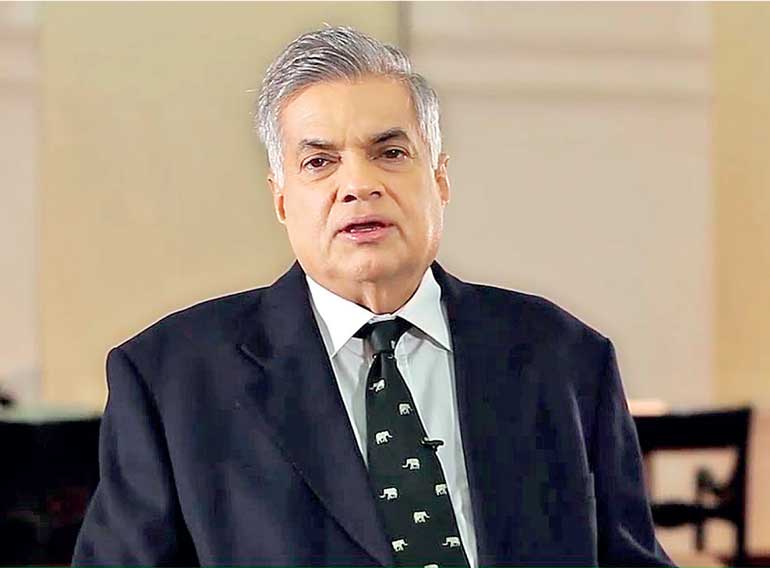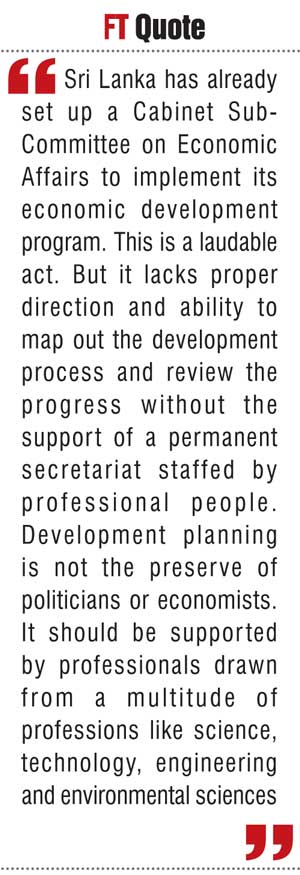Monday Dec 22, 2025
Monday Dec 22, 2025
Monday, 16 November 2015 00:10 - - {{hitsCtrl.values.hits}}

A fourth wave of policy reforms
The economic policy statement presented by the new Government has vowed to introduce a reform program laying a firm foundation to place the economy on the right track so that it can sustain growth and prosperity.
The statement has identified different reform regimes introduced in the country since 1978 and calls the current reform programme as the Third Wave of such reforms. The first and the second reforms, according to the statement, had been introduced by J.R. Jayewardene in 1978 and R. Premadasa in 1989.
However, the statement had missed the third wave of reforms implemented by Chandrika Bandaranaike Kumaratunga from 1994 to 2001. Her reform program too was not completed as was the case of the two previous programs. But it was during her period that reforms were introduced to telecom, airline, plantation and gas sectors. When this third wave of reforms is considered, the current program proposed is not the third wave but the fourth wave of reforms. 
Political consensus a must for proper implementation of a plan
The existence of three previous uncompleted reform programs demonstrates one fundamental flaw in economic reforms of the country. That is, failing to get political consensus for reforms surely derails the whole program once the political power has been changed.
This was evident when the current Prime Minister attempted an economic reform program when he held onto power during 2002-2004. The initial ground work for reforms were laid by him but they were all thrown away when the power changed hands in 2004. The market is not happy about the country attempting reform programs with a lot of fanfare and then throwing them away midway through by successive governments.
Private sector demands continuity in policy
This was an issue raised at a recent seminar held in Colombo by the Sunday Times Business Club to discuss the forthcoming budget. At the discussion time, the audience wanted to know how the continuity of the current policy package could be ensured in a background of failures in the past.
Two suggestions were made. One was to get a political consensus for the reform program and it was pointed out that the current political get-together by the two rival parties which have the prospect of forming future governments offers the ideal opportunity for building such a consensus.
The other was to establish a policy management mechanism so that effective implementation of the current policy package could be assured. Hence, signing off the policy package by the two main political parties which have come together to form the new Government is a must. This should simultaneously be followed by the establishment of effective implementation machinery.
Promoting exports at the centre of the policy
The EPS of the Government is a skeleton that has outlined what the Government is planning to do to deliver prosperity to the nation in the future. The skeleton, as has been presented by the Prime Minister, is three pronged, namely, the emphasis placed on exports for creating wealth, the need for introducing new technology to transform the production mix of the country and measures to make available the fruits of developments inclusively to people at large. This skeleton has to be developed into an implementation plan consisting of three main components in it. One should be cautioned that it would not be a plan in the way plans were formulated in old centrally planned economies. Rather, it would be plan containing guiding principles for the Government to achieve its objectives in the most efficient and effective manner.
Production should be in value-added areas
First, it has to set the physical targets which the plan aims at achieving at the national level. For instance, it has to clearly lay down the rate of growth which the country aims at achieving in the next 5 to 10 year period in the form of a rolling plan where the targets are revised continuously in each subsequent year based on the emerging ground realities and the developments of the global markets – favourable or unfavourable – the country is faced with.
These national targets in the plan have to be broken into sectoral targets and sectoral targets into separate programs and program targets. The programs have to be further broken into action plans with separate time frames for each action plan. For instance, the action plan, say, of the coconut sub sector, should elaborate on the introduction of technological breakthroughs that enable the sector to capture the world market by newly invented and innovated value added products.
A qualifying candidate, for example, is the use of virgin coconut oil in the production of cosmetics, drugs or health foods. The call for such scientific breakthroughs should come from the sector itself that has to work with the relevant research institutions and universities.
In other words, the sector has to commission research into the area by indicating its requirements to the research institutions concerned. This involves the coordination of work among different government and private sector organisations on a priority basis.
Funding should not be ignored
Second, the plan should indicate how the funding should be generated for its implementation. Most of the plans formulated in the past, such as the Ten-year Plan of 1959 or the Five-year Plan of 1971 lacked this vital requirement. A part of the funding should come from the state budget, a part from the private sector and a part from donors and multilateral lending agencies.
To generate the capacity for funding, the budget should be reformed to generate a surplus in its revenue account and transferring the surplus to the capital expenditure program.
A clue to this has been indicated by the Prime Minister when delivering EPS commenting that the nation had been living in the past beyond its earnings. The Minister of Finance, who has the command over the budget, should immediately take a cue from this and start introducing necessary budgetary reforms.
In the mid 1960s, economist B.R. Shenoy, who was engaged by J.R. Jayewardene to propose such a development plan, suggested that Sri Lanka should go for a zero budget balance system whereby the needed resources are generated in the budget itself through savings in its revenue account.
It also obviates the necessity for continued borrowing by the Government and thereby adding to public debt in each of the subsequent years (A review of Shenoy’s recommendation is available at:http://www.ft.lk/article/432905/The-ignored-B-R--Shenoy-Report-of-1966:-An-instance-of-missed-opportunity-for-Sri-Lanka?).
The use of the private sector funding should be encouraged through appropriate government policies. Once the plan is in readiness, the government can start negotiations with donors for funding certain parts of the plan.
Progress review should be done continuously
Third, the plan should also lay down the mechanism for progress review with key performance indicators clearly outlined for comparing with actual results. For instance, the performance of research institutions and universities should be evaluated on the basis of new patents which they have obtained for new research breakthroughs.
A simple example is, say, the development of a roofing tile with a solar panel embodied to it to capture solar energy as a renewable energy source. Without this mechanism, a plan is just a document with no practical use at all. In the past, many initiatives started by the governments in power did not yield the required results because there was no effective mechanism for progress review and taking corrective action if the plan has underperformed.
Sri Lanka could take guidance from the initial development management strategies of both South Korea and Singapore in this regard.
Korean Economic Planning Board
A report issued in 2014 by South Korea’s Ministry of Strategy and Finance together with its KDI School of Public Policy and Management under their Knowledge Sharing Programme has documented the experience of Korea Economic Planning Board (EPB) in the initial years of its economic progress.
The report titled ‘Operation of Economic Planning Board in the Era of High Economic Growth in Korea’ is available at: http://www.ksp.go.kr/common/attdown.jsp?fidx=402&pag=0000700003&pid=128 .EPB was set up on the initiative of President Park Chung-hee who came to power in 1960 through a military coup. At that time, South Korea was a sick patient in Asia with a per capita income of only $ 80 and massive poverty all over. A quick economic recovery was needed to prevent the country from falling into social and political chaos which were to be used to its advantage by its fraternal neighbour, North Korea. That was the reason for introducing a proper economic policy management by President Park.
EPB was placed under a Deputy Prime Minister
The national economic management structure introduced by President Park had the national goal of developing a self sufficient economy with self-defence capability. Given the threat posed by North Korea, these two national objectives by South Korea in early 1960s are understandable.
To attain this objective, Five Year Plans were introduced under the direct supervision of the President himself. The structure involved the President and Prime Minister under whom the newly established EPB was set up. To emphasise the importance of EPB, it was placed under the management of a newly created Deputy Prime Minister who concurrently held the post of EPB Minister as well.
In the initial period, the function of EPB was threefold: planning, budgeting and cooperation. Planning function included “not only the simple formulation of short- and long-term economic plans, but also developing policy measures to respond to the constantly arising economic issues.
Therefore, performing its planning function naturally involved matters falling under the administration of other government ministries, which meant that consulting and coordinating with other ministries was essential.
In other words, this planning function included a coordinating function, while the budget function (mobilising domestic capital) and the cooperation function (attracting foreign capital), acted as two important pillars that backed up this main function” (p 16).
EPB was to prepare plans
Four functions were assigned to EPB: Designing overall plans, managing their implementation, procuring resources for plans and researching on economic development including the compilation of economic statistics.
To effectively run its affairs, several bureaus that had been operating in other ministries too were absorbed into the EPB. They were the overall planning bureau, budget bureau, materials mobilisation planning bureau and statistics bureau. The monthly progress review and problem solving meetings of EPB were chaired by President himself.
Singapore too had an Economic Development Board
Similar to South Korea, Singapore too set up an Economic Development Board in 1961 to plan and execute strategies for enhancing Singapore’s position as a global business centre and growing its economy.
It sought to create opportunities and jobs for the people of Singapore and thereby shape the country’s economic future. Today, it runs a website which gives comprehensive information to anyone who seeks to establish business in that country (available at: https://www.edb.gov.sg/content/edb/en/about-edb.html ).
Thus, its job has been to facilitate and support both local and foreign investors in manufacturing and services sectors to develop and expand new business opportunities, especially those involving capital-intensive, knowledge-intensive and innovation-intensive activities.
The experience of Singapore with respect to EDB and its strong points have been documented by the World Bank in a paper titled ‘Singapore Local Economic Development: The Case of Singapore Economic Development Board’ (available at: http://siteresources. worldbank.org/ INTLED/ Resources /339650-1194284482831/4356163-1211318886634/Singapore Profile.pdf ).
Proper economic management requires managing for development results
Economic planning is not an easy task for any country. It involves the elaborate preparation of plans in terms of national objectives that have been decided by taking into account emerging global trends and where the country wants to place itself in that global arena. Sri Lanka has chosen to become a nation of worth in this arena.
However, the management of that process to reach its goal is the gigantic task it now faces. This involves economic policy management. The veteran national planner, Dr Lloyd Fernando, has recommended in a recent paper that Sri Lanka should adopt the approach of Management for Development Results (MfDR) and for that purpose, the country should rediscover the Department of National Planning which had been serving a catalytic function in good old days but has gone into permanent disuse in the present period. His observation is that without undertaking a simultaneous reform of the government bureaucracy across all sections, the implementation of any national plan would become fruitless.
Suitable mechanism to implement the policy a must
Sri Lanka has already set up a Cabinet Sub-Committee on Economic Affairs to implement its economic development program. This is a laudable act. But it lacks proper direction and ability to map out the development process and review the progress without the support of a permanent secretariat staffed by professional people. Development planning is not the preserve of politicians or economists. It should be supported by professionals drawn from a multitude of professions like science, technology, engineering and environmental sciences.
To support this, it is recommended that Sri Lanka should set up a National Planning Council in the style of the Economic Planning Board of South Korea. This National Planning Council should be a permanent body made of professionals belonging to diverse fields. It can report to the Cabinet Sub-Committee on Economic Affairs periodically.
In this manner, the country can ensure the continuation of the economic policy package introduced by the government about which the private sector has expressed its concerns.
(W.A. Wijewardena, a former Deputy Governor of the Central Bank of Sri Lanka, could be reached at [email protected] )